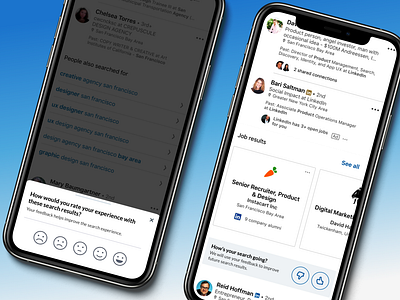LinkedIn — Global Search Feedback I (Mobile)
Hello, Dribbblers!
Search engines are constantly trying to provide the most relevant and satisfying results for their users. But how do they know what users want and how they react to the results? One way is to collect and analyze user feedback (explicit signals), which can help improve the search algorithms and the user experience.
I'm pulling back the curtain on a LinkedIn project I worked on in the past that aimed at improving the search experience of members. We're talking about quick, effortless, and non-intrusive feedback mechanisms right within your search results for people, jobs, companies, events—you name it. The magic doesn't stop there. These user reported signals are then fed into machine learning algorithms to fine-tune search relevance. I personally prefer the thumbs-up/thumbs-down feedback approach. What about you?
Benefits of using user feedback and behavior data
Using user feedback (explicit signals) and behavior data (implicit signals) can have several benefits for improving search results, such as enhancing the accuracy and relevance of the results to match user intent, increasing user satisfaction and loyalty, boosting engagement and retention, improving trust and confidence, and driving user action and conversion. By providing users with results that are tailored to their preferences and goals, the search engine can demonstrate that it cares about their feedback and behavior, motivating them to take the next steps.
Keep your eyes peeled for more snapshots of this project in the pipeline.
Feel free to hit 'L' if you find this intriguing, and consider following me for more behind-the-scenes peeks into my design adventures.
